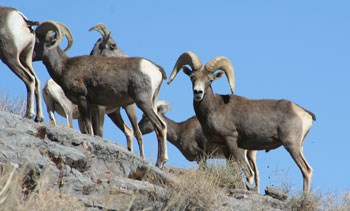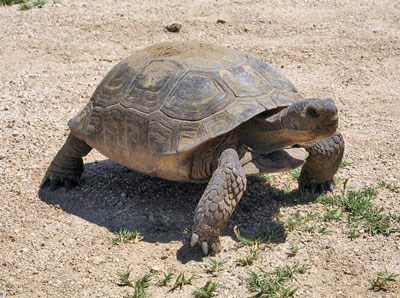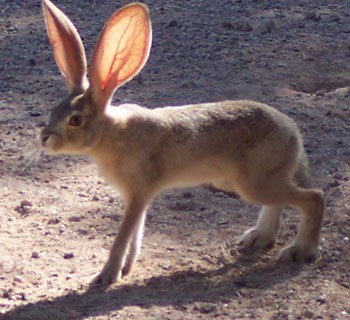How Many Animals Live In Death Valley
Animals
| Hear the words "Expiry Valley" and an image of an uninhabited landscape might come up to heed. Below-sea-level basins are ravaged by drought and oestrus, receiving less than ii inches of rain per yr. Temperatures soar above 120 degrees. While these conditions may seem harsh to humans, Death Valley is home to a peachy diversity of wild fauna. Hard-learned, clever adaptations enable desert animals to thrive in this unlikely identify.  NPS photo Expiry Valley is one of the driest places on globe. Habitats with fresh water can be hard to find, so some desert animals accept evolved to but drink less water. Roaming through mountains and canyons, bighorn sheep are able to go without h2o for several days and tin lose up to a third of their body weight due to dehydration. When water becomes available again, the sheep can drink several gallons at a time to rehydrate. Similar bighorn sheep, kangaroo rats do non have to worry well-nigh dehydration. In fact, they are so perfectly adapted to arid environments, they do non need to drink water their entire lives! They can survive on water digested from their seedy, vegetarian diet. Kangaroo rats conserve their body's precious water by releasing wastes in very concentrated urine and dry feces.  NPS - Robb Hannawacker While finding enough water is a challenge, coping with the tearing summer estrus is a abiding concern for desert inhabitants. The desert tortoise is a champion of fugitive the heat. Unable to regulate its ain temperature, the tortoise spends most of the year in its burrow. Underground, it is protected from farthermost atmospheric condition. During the hottest times of the year tortoises estivate, entering a state of dormancy that allows them to conserve energy and save h2o. Additionally, desert tortoises survive frigid wintertime temperatures past hibernating. Depending on the weather, desert tortoises might be active above ground for simply three months of the year! Rather than "sleep" through nigh of the year, many animals rest during the hot summer days and are active at night. Nocturnal wild animals leaves behind clues on sand dunes. For example, yous may find coyote tracks aslope those of a jackrabbit. The rabbit'southward tracks zig and zag across the sand while the long strides of the coyote's tracks portray a fast run. Hunting during the cool nights and early mornings allows the coyote to spend more energy catching casualty. The encompass of darkness also helps the jackrabbit hide from potential predators. While there are advantages to being nocturnal in the desert, there are even so creatures who dauntless the daytime heat. Unremarkably seen animals have specific physical adaptations which allow them to exist out in the heat longer. Roadrunners, for case, can operate in the estrus of the day considering their torso temperatures are naturally high (104 °F).  NPS / K Monroe The jackrabbit, another common desert creature, stays cool by releasing heat from its over-sized ears. When the rabbit retreats into the shade, warm claret from its core circulates through claret vessels in its ears, releasing torso heat into the surrounding air. Desert living is no like shooting fish in a barrel task, but all animals that brand their dwelling in Expiry Valley accept found a way to survive and thrive. Their adaptations overcome the daily challenges of finding nutrient, h2o, and staying absurd. "Helping" an animal by giving information technology nutrient or other interactions can disrupt its way of life and usually does more harm than good. Desert dwellers are perfectly designed to live in Death Valley National Park. It is of import that humans, equally visitors to these creatures' dwelling house, respectfully observe and bask from a distance. |
| |
| |
Last updated: September 29, 2021
Source: https://www.nps.gov/deva/learn/nature/animals.htm
Posted by: culbertsoncrin1958.blogspot.com

0 Response to "How Many Animals Live In Death Valley"
Post a Comment